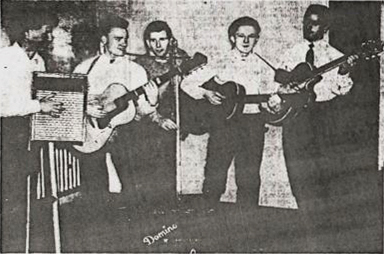 Rock and roll was born in the mid-1950s and took off in a big way with the young generation. To them it was a modern form of jazz. They danced to it in the same way their parents danced to Dixieland, Boogie and Swing. For those with a feel for music, rock and roll was easy to play. Popularity and success followed. Critics and real musicians, with years of training and practice behind them, resented this.
Rock and roll was born in the mid-1950s and took off in a big way with the young generation. To them it was a modern form of jazz. They danced to it in the same way their parents danced to Dixieland, Boogie and Swing. For those with a feel for music, rock and roll was easy to play. Popularity and success followed. Critics and real musicians, with years of training and practice behind them, resented this.
Then, in 1957, skiffle came along. Skiffle could be described as poor man’s rock and roll. A guy who could play a few chords on a guitar could form a group by persuading two friends to join him, one with a homemade box bass and the other with a washboard. For some of the professionals this was the last straw, their resentment came very close to hostility. In spite of this, several groups achieved such a level of acceptance and popularity that skiffle could not be ignored.
Across the water, in England, skiffle groups were formed by people who later became big names, such as Lonnie Donegan, The Beatles and Cliff Richard.
To keep their dancing patrons happy in the Dublin ballrooms some bandleaders, such as Jimmy Honeyman in the Olympic, Earl Gill in the Four Provinces and Johnny Butler in the Ballerina formed skiffle groups as an added attraction, using their own band members. Any small group which included a washboard and box bass was described as a skiffle group, no matter what they played.
Scores of groups appeared out of nowhere and disappeared almost overnight. In Dublin, indeed in Ireland, the skiffle scene was dominated by a small number of groups. The Atoms, The Louisiana, The Domino (pictured above) and The Dave Kane Group.
All four had been finalists in the skiffle Contest which was held in the Top Hat Ballroom in Dun Laoghaire in late ‘57 and early ‘58, the Atoms being the overall winners.
The Atom Skiffle Group, under leader Paul Maguire, from Rathfarnham, was booked for the Theatre Royal on several occasions, and also performed at the prestigious Herald Boot Fund charity show in the Capitol Theatre.
The Louisiana Group was formed in Leeson Street by Brian Brereton, with the help of his dad. Other members were the Drennan brothers, Willie Sunderland, Eddie Dalton and Sean Fagan. They performed around the city, mainly on the Southside. Many years later, Brian assisted his son in reforming and updating the group.
The Domino Group was put together in Cabra. Their first shows were at the local Boys’ Club. Soon they too were moving around the city.
Dave Kane, reportedly from Glasthule in south Dublin, led an outfit which went through several name and style changes. They appeared on the Theatre Royal as a rock and roll band in March, 1958.
By Ken Casey

